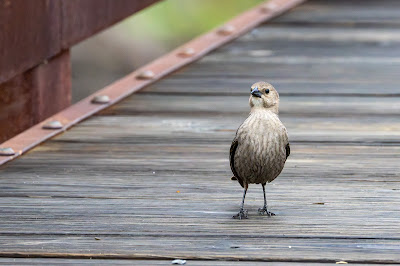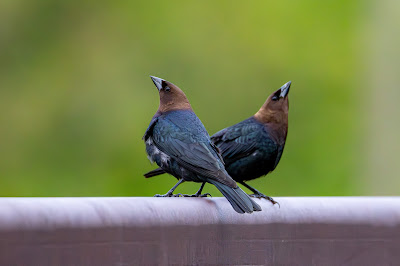Four Mile Run Conservatory Foundation
Wednesday, December 10, 2025
Kayak Launch Construction Complete!
The Foundation engaged Rummel, Klepper & Kahl for the engineering design and environmental assessment/permitting, and Alexandria-based Landivar & Associates as general contractor. Work began in March of this year. Project funding was supported by grants from the Virginia Department of Conservation and Recreation’s Recreational Trails Program, the American Water Charitable Foundation, the National Fish and Wildlife Foundation’s Chesapeake WILD program, the National Park Service Chesapeake Gateways program, and the Community Matching Fund of the Alexandria Department of Recreation, Parks, and Cultural Activities, as well as through the generous support of local community members.
The kayak launch is open and available for use by non-motorized watercraft. A ribbon-cutting and dedication ceremony is planned for Spring 2026.
Saturday, November 15, 2025
Habitat Restoration Areas at Four Mile Run
The City of Alexandria’s Department of Recreation, Parks, and Cultural Activities (RPCA) has teamed up with the Alexandria Beautification Commission (ABC), Arlington Regional Master Naturalists, and the Four Mile Run Conservatory Foundation to launch a new habitat restoration pilot in Four Mile Run Park.
For this pilot program, two sections along the park’s forest edge have been set aside as Habitat Restoration Areas (HRAs)—places where nature will be given space to thrive. The project will use both natural regeneration and hands-on planting to restore native plants, improve wildlife habitat, and strengthen the park’s ecosystem.
Four Mile Run is an important part of the Potomac River watershed. Its wetlands and wooded buffers help filter stormwater, provide corridors for birds and wildlife, and add to the park’s beauty. As nearby development grows, this project will help protect these vital natural areas for the future.
City staff and volunteers will work together to plant natives, manage invasive species, and create educational signs, so visitors can learn about the restoration process. Please come out and volunteer! Check the calendar for the regularly scheduled volunteer days, the first Saturday of the month. Look forward to seeing you in the park!
Friday, July 25, 2025
Who’s At Four-Mile-Run Park this Summer?
 |
| Alexandria Late Risers rowing team in Four-Mile-Run Stream. Photo Credit: Jean Garner |
Wait, is that a crew shell in Four-Mile-Run Stream? Yes, and it’s one of the many boats that use the stream for recreational paddling or fishing. As the largest stream flowing through Arlington and bordering Alexandria, Four-Mile-Run attracts a variety of watercraft that, depending on rainfall, tides, and hull depth, can travel as far inland as the intersection with West Glebe Road.
 |
| Location of the Washington family’s mill property. Photo Credit: Devry Becker Jones. |
Historically, boats, which could get nearly to Shirlington, may have carried loads of grain. During the 18th-19th century, the stream was flanked by multiple watermills for grinding corn and wheat, including several in Arlandria just upstream of Four-Mile-Run Park. George Washington owned land a bit further up at the Run’s confluence with Upper Long Branch Stream. You can see the Arlington Mill marker where Washington’s step-grandson built a mill on the property in 1826.
Deforestation of the original oak hickory forest eventually rendered Four-Mile-Run the site of heavy runoff and devastating floods. After a 1972 flood, the Army Corps of Engineers channelized the stream’s lower half mile for flood control. The channelized portion, bound by cement barriers and riprap, is largely what we see now in Four-Mile-Run Park. The stream topography today is dramatically different from its original form.
With the Potomac River often buffeted by winds and motorboat traffic, Four-Mile-Run stream provides a recreation refuge. Boaters entering the stream from the Potomac must navigate through multiple bridges under roads and railroads. Kayakers who rent boats from the Washington Sailing Marina likewise enter from the river. The low clearance prevents sailboat passage into the stream, but small motorboats enter to fish for largemouth bass, bluegill, and catfish.
 |
| Paddleboarder riding the waves of the Water Control plant effluent. Photo Credit: Devin Reese. |
Today, the water gets increasingly shallow as you go upstream, except for the churning influx of sanitized water from the Arlington Water Pollution Control Plant just behind the Observation Deck (a prime birding spot). Boaters also also access Four-Mile-Run from an old ramp close to where Commonwealth Avenue meets the stream. Muddy but functional, it serves as the launch point for the regular stream clean-ups by kayak.
Boating in a stream that receives water treatment effluent and street runoff begs safety questions. As an urban stream, Four-Mile-Run suffers contamination, such as during this 2021 incident. But the Northern Virginia Regional Commission and City governments run regular water quality monitoring programs for the stream (see HERE), issuing alerts as needed, and always discouraging swimming.
As long as you’re planning to stay in your watercraft, you can safely boat on Four-Mile-Run stream. To boost access, a project is in the works for a new kayak launch. A collaborative project between the Four Mile Run Conservatory Foundation and City of Alexandria, the launch will be the first site on the Potomac River to provide ADA-compliant access for kayaks and canoes. Learn more HERE.
 |
Style of the future boat launch on Four-Mile-Run. |
Monday, July 7, 2025
Who's At Four-Mile-Run Park this Summer?
At Four-Mile-Run Park, you may notice that bird sounds have
quieted down with the onset of hot summer weather. By now, many migratory
songbirds from the tropics, such as yellow and blackpoll warblers, have headed south
after fledging single nests. They’re getting a leg up (wing up!) on their long
journeys to Central and South America.
But the year-round residents are still breeding during July.
Watch and listen for nests with squeaky broods of sparrow hatchlings, thumb-sized
broken American robins’ blue eggshells, or fat, newly fledged grackle nestlings
poking around on the ground.
If you see an extra-large egg or hatchling in a nest, you’re witnessing parasitism in action. Spot evidence of a parasite:
 |
Brown-headed cowbird egg in black-capped vireo nest in Oklahoma. Photo Credit: Christine
Fallon/USFWS. |
 |
Brown-headed cowbird nestling in Kirtland’s warbler nest. Photo Credit: Cassandra Waldrop/USFWS. |
 |
What nest is this cowbird female at 4-Mile-Run scoping out? Photo Credit: Matt Strachan. |
So, the brown-headed cowbirds spotted this month at Four-Mile-Run are likely up to no good, well good for them but not for other bird species. Ameliorating the impacts of cowbirds on the reproduction of native birds has long been a conservation concern, prompting the formation of a North American Cowbird Advisory Council to make recommendations for managing cowbird populations.
Historically, cowbird impacts would have been muted by their movements with bison, but cow herds are fenced in and not migratory. These days, brown-headed cowbirds threaten other bird species as far north as Alaska and south into central Mexico.
 |
| Brown-headed cowbird males spotted at Four-Mile-Run Park. Photo Credit: Matt Strachan. |
Thursday, June 19, 2025
Who’s At Four-Mile-Run Park this Summer?
.jpeg)
Chewed Beaver Stump. Photo Credit: Kurt Moser.
If you
hang around the stream, you may notice shady evidence of lumberjacks harvesting
wood along its banks. Entire trees are toppled over or encircled with telltale
chunks missing from their midsections. Sharpened stumps dot the landscape like
giant pencils shoved eraser-first into the ground.
But what appear to be signs of human axes at work are traces of a mammal that has inhabited Virginia for millions of years – the North American beaver (Castor canadensis). Despite beaver hunting by Native Americans followed by intensive trapping by European colonists for their pelts, beavers persist. But thanks to legal protection beginning in the late 19th century, beaver populations have rebounded from their extirpation in Virginia to today’s beaver presence in every VA county.
And
the engineering talents of beavers are shaping the habitats of Four-Mile-Run
stream. Peering over the red bridge just before the nature trail, you’ll see a
dam that beavers have been building this summer. It impounds water from Hume
Springs right before it reaches the run, creating a tranquil ponded area
for beaver homes. 
Beaver dam where Hume Spring meets Four-Mile-Run.
Photo Credit: Kurt Moser.
With their hard enameled front teeth (a feature of all
rodents), beavers harvest trees for materials to build dams and lodges. Glued
together with a combination of sticks, grasses, and mud, these sturdy structures
usually hold up well. Although heavy rains washed out the beaver’s dam in early
June, they have been gradually rebuilding it to maintain habitat for their domed
lodges.
A lodge is another engineering feat; one or more underwater entrances lead to a dry platform inside for sleeping and raising litters of 3-5 young per year. A beaver chooses a mate for life, co-parenting each offspring in the lodge for about two years before sending them off to start a colony of their own. Only if a mate dies will a beaver take up with a new partner.

Beaver caught in the act of gnawing bark off wood. Photo Credit: Todd Kiraly.
This time of year, newborn beaver kits are sheltered in the lodges while older siblings explore outside. Because beavers are nocturnal, you’ll be lucky to spot one in the daytime, but they occasionally cruise around at dawn or dusk feeding on plants and adding to their construction projects. If you suddenly hear a SMACK sound, it’s a beaver slapping its tail on the water to send an alarm signal to its family that danger – likely YOU – is lurking nearby.
In addition to using trees for building, beavers eat them.
They’re wholly herbivorous, feeding on leaves, bark, and twigs of riparian saplings
like aspen, willow, tulip poplar, and maple. A suite of adaptations equips beavers
for a stream lifestyle: ear and nose flaps to keep water out when swimming; webbed
hind feet for paddling; a rudder-like tail that stores fat; and a gland that
produces water repellant for their fur. And, if you hear whines, grunts, or
snuffles at dusk near Four-Mile Run, you may be listening to beavers chatting!
.
Beaver eating stream vegetation. Photo Credit: Matt Strachan.

